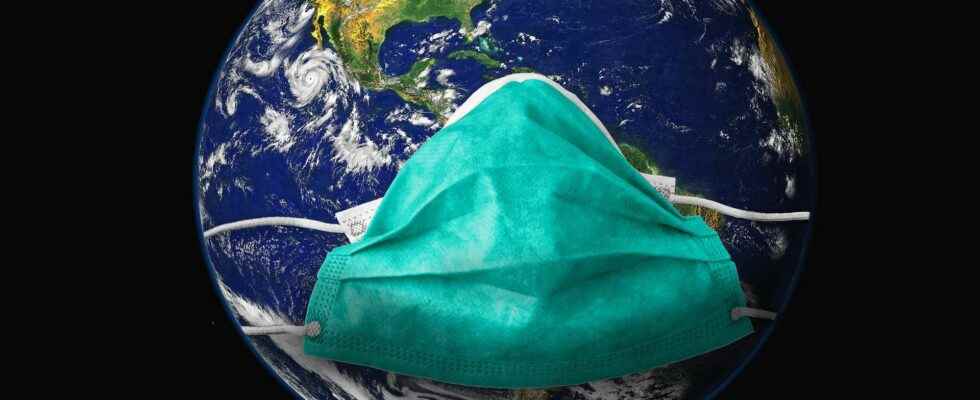A new study explains how the joint migration of animals and humans, linked to global warming, will trigger new pandemics.
You will also be interested
[EN VIDÉO] Wild animals in the face of global warming Even very slight changes in climate can strongly affect the biodiversity of an area, and even lead to the disappearance of animals. This is why the CLS, which specializes in the protection of wildlife, strives to monitor vulnerable species such as the king penguin or the elephant seal on a daily basis and by satellite. Here is a video overview of the work carried out in the Arctic .
the Georgetown University Medical Department just published a study on the link between climate change and the transmission of viruses, in the review Nature.
The rise in temperatures and the multiplication of phenomena weather report extremes have a well-known indirect impact on the development of epidemics : after’Hurricane Matthew that devastated Haiti in 2016, an epidemic of cholera affected children. After each typhoon in Asia, cases of Dengue agent
The dengue virus is the dengue virus, belonging to the family Flaviviridae, genus Flavivirus, and therefore a cousin of yellow fever viruses and the…” data-image=”https://cdn.futura-sciences.com/buildsv6/images/midioriginal/5/6/b/56b4fc08d9_50036069_aedes-albopictus-james-05.jpg” data-url =”/health/definitions/dengue-medicine-8078/” data-more=”Read more” title=”Dengue” href=”https://www.futura-sciences.com/health/definitions/dengue-medicine -8078/”>dengue fever are multiplying. A climate hot and humid indeed affects the breeding of mosquitoes and leads to increased risks ofepidemics of malariabut also Chikungunya virus (ChikV)
Alphavirus of the Togaviridae family (group A arbovirus), the chikungunya virus (ChikV) is…” data-image=”https://cdn. futura-sciences.com/buildsv6/images/midioriginal/6/f/a/6fa3bf2456_104064_chikungunya-aedes-aegypti.jpg” data-url=”/health/definitions/medicine-chikungunya-4143/” data-more=”Read the suite” title=”Chikungunya” href=”https://www.futura-sciences.com/health/definitions/medicine-chikungunya-4143/”>chikungunya.
Gatherings of species that should not mix
But a new parameter should have more and more repercussions on human health: the movement of populations, both human and animal. Global warming leads to more and morespecies wild to migrate to new habitats, but wildlife often reaches the same destinations as the human population. The relocation of different animal species and the human species to the same areas could lead to the next global pandemic: the proximity of several species of mammals which are not supposed to meet will most certainly lead to the transmission of thousands of viruses according to the study. Among the most transmissible viruses between different species of mammals, Ebola and coronavirus easily migrate from animals to humans.
The author of the study Colin Carlson explains that the unhealthy conditions that we are currently experiencing in live animal markets are comparable to those that we may find later in the areas occupied by climate refugees: in both cases, we finds gatherings of various species that should not be brought together. These climatic migrations have already begun since the temperature rise reached 1.2°C compared to the pre-industrial era.
Bat migration will definitely cause zoonoses
Researchers are particularly concerned about the effects of rising temperatures on bats. These small flying mammals are a natural reservoir of viruses such as Ebola and the various SARS. The fact that they are long-term hosts of viruses and can fly great distances makes them particularly dangerous in climate migration. Due to the great diversity ofbat species and its vulnerability to climate change, Southeast Asia (China, Taiwan, Vietnam, Cambodia, Laos, Philippines, etc.) is the area most likely to promoteemergence news epidemics.
According to the Georgetown researchers, the question is not whether these climatic migrations will lead to new viruses (because it is a near certainty), but rather how much these zoonoses will affect humans. Ebola, Zika and the Covid-19 have already proven the devastating effects of virus transmission between exotic animals and humans. The only solutions to limit the risks of new pandemics according to the authors: try to preserve the natural habitats of endangered fauna as much as possible, in order to ensure that they stay as long as possible in their area of origin, but also to set up a protocol monitoring of host species migrating to new destinations. ” When a Brazilian bat decides to settle in the Appalachian region of the United States, it is better to know what viruses it carries “says Gregory Albery, one of the authors of the study.
Researchers at Georgetown University are convinced that the climate change is now the main cause of the emergence of animal-human viruses, ahead of the trade in wild animals, the deforestation and intensive agriculture.
Interested in what you just read?
